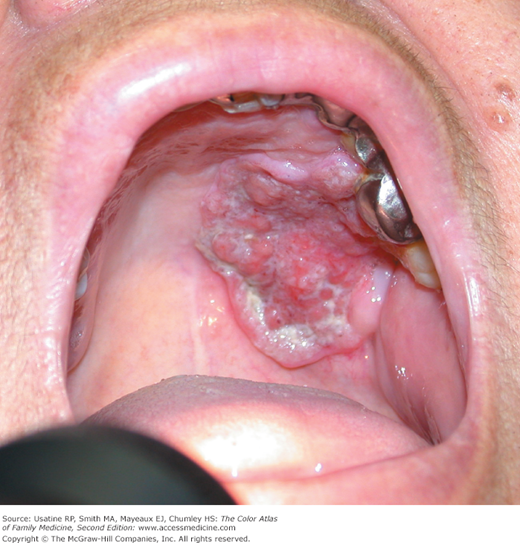Patient Story
A 66-year-old man presents to the physician’s office with a nonhealing painful lesion on the roof of his mouth (Figure 43-1). The lesion has increased in size recently and he is worried because his dad died from oral cancer. Your patient has smoked since he was 11 years old by getting cigarettes from his dad. He admits to being a heavy drinker. A biopsy shows squamous cell carcinoma and the patient is referred to a head and neck surgeon.
Introduction
In spite of the relative ease for the healthcare provider to accomplish a visual and tactile examination of the oropharyngeal cavity, fully two-thirds of oropharyngeal cancers (OPCs) will present with advanced disease at the time of diagnosis.1 Ninety percent of OPCs are of the squamous cell type. Concern has been raised that practitioners are missing early disease by not accomplishing a thorough soft-tissue examination on a routine basis.2 However, the fact that more than 35% of patients do not see a dentist on a routine basis likely contributes to the diagnostic delay.3 The 5-year survival rate is 62% for whites and 42% for blacks.1
Synonyms
Epidemiology
- In the United States, an estimated 40,000 OPC cases occur annually, accounting for approximately 3.3% of malignancies among men and 1.5% of malignancies among women.1
- The median age at diagnosis is 62 years and more than 70% of cases occur after the age of 55 years.4
- Incidence rates vary from a low of 3.9 per 100,000 Hispanic women to a high of 16.1 per 100,000 white men.4
- Up to 35% of OPC patients will develop a new primary tumor within 5 years.5
Etiology and Pathophysiology
- Typical OPC develops from a complex multistep progression marked by alterations at the molecular level, followed by phenotypic changes and subsequent clinically observable changes affecting the squamous epithelium.6
Risk Factors
- Tobacco use is the major risk factor for OPC and is implicated in approximately 75% of cases.7
- Alcohol use is a major risk factor and the combined use of tobacco and alcohol increases the risk of OPC far more than either alone.7
- Human papillomavirus (HPV) (especially HPV 16) is a newly recognized major risk factor for carcinomas affecting the lingual and palatine tonsils.8
- Other risk factors include betel quid chewing, low intake of fruits and vegetables, immunosuppression, and maté drinking.9
- Excess sun exposure is the major risk factor for cancer of the lip.7
Diagnosis
- OPC may affect any area of the oropharyngeal cavity.
- Early OPC often presents as a leukoplakia or erythroplakia (Figure 43-1). High-risk sites are the floor of the mouth and ventrolateral tongue (Figure 43-2).
- Features of more advanced disease include induration, persistent ulceration, tissue proliferation or erosion, pain or paresthesia, loss of function, and lymphadenopathy (Figures 43-3, 43-4, and 43-5).10
- HPV-associated carcinomas are often less visible and share signs and symptoms (e.g., sore throat, hoarseness, earaches, enlarged lymph nodes) of tonsillitis and pharyngitis. More advanced symptoms include dysphagia, hemoptysis, and weight loss.10
- Lip cancer typically presents as a relapsing or persistent chronic scab, plaque, crust, or ulceration (Figure 43-6). Antecedent actinic cheilosis is commonly observed.
- Nonsquamous type cancers (e.g., salivary gland tumors, melanoma, sarcomas) often present as a submucosal nodular swelling or mass (Figures 43-7 and 43-8).
Stay updated, free articles. Join our Telegram channel

Full access? Get Clinical Tree



